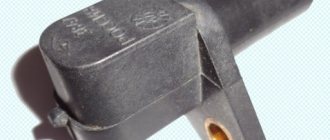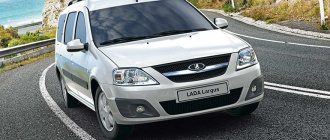- AvtoVAZ
By
admin
—
04.08.2019
830
In the modern world, where the price of fuel is constantly rising, it is necessary to think about how to save on your movement. Giving up the car is not an option, but trying to reduce fuel consumption, in particular on the Lada Granta, can be considered an acceptable option. This is exactly what we will talk about today.
What is the fuel consumption of the Lada Granta per 100 km?
Lada Granta is a car for those who need an inexpensive car with low fuel consumption. Let's look at the Lada Granta's fuel consumption per 100 km.
According to the manufacturer, the average fuel consumption of the Lada Granta per 100 km is about 7 liters for the Granta Sedan and Granta Liftback models, as well as 6.8 liters for the Granta Sport models.
The engines of the Lada Granta car are small-displacement units that, in principle, cannot consume large amounts of fuel, although there are a number of factors that affect the fuel consumption of the Lada Granta:
1. Car equipment 2. Brand of gasoline 3. Traffic congestion 4. Driving style 5. Air conditioning and other electronics on 6. Weather season 7. Malfunction of the engine and other components of the car
Let's take a closer look at these factors affecting the consumption of the Lada Grant.
Chassis
Many elements of the car's chassis can be inspected even without the help of a service center or a lift. All pendants are so simple that small flaws should not become an obstacle to purchase: they can be repaired quickly and inexpensively. You just need to make sure that, for example, a strongly and unevenly balding tire was not the result of a serious accident with deformation of the mounting points of the suspension parts.
I would advise choosing a car modification with ABS. Of course, you can do without it in modern heavy traffic, but extending the compulsory motor vehicle insurance policy is painfully expensive, and you can easily drive into the rear of the car in front and not meet the limit of a regular “motor vehicle” license.
Vehicle equipment
A very significant factor when taking into account the consumption of a Lada Grant is the vehicle’s equipment; here it is important to understand that by vehicle equipment we mean all sorts of variations in the assembly of the model, such as different bodies, engines, mechanical parts and electronic equipment, officially presented by the manufacturing company.
For example, “Granta Sedan” and “Granta Liftback” are available in three versions with 98/87/106 HP engines, gasoline consumption per 100 km of the Lada Granta is 7.8/7.2/6.9 liters, respectively, and the fuel consumption of the Lada Granta 8 valve is 7 .2 – with an 87LS engine, while the other two configuration options 98LS and 106LS are represented by 16 valve engines.
The situation is slightly different in the Granta Sport model, although the engine displacement of this car does not differ from other trim levels (1.6 liters), in this version of the car there is a noticeably increased power of 118 HP, the engine also has 16 valves for circulating the fuel mixture and a 5-speed gearbox. gearbox
An interesting fact regarding the Granta Sport is that, according to the manufacturer, the gasoline consumption of the Lada Granta Sport is only 6.8 liters per 100 km - which, apparently, is the smallest figure among all the above-mentioned trim levels.
DIY replacement instructions • With VAZ-11183-50 16 82 l engine
| Fuel consumption of Lada Granta per 100 km. manual and automatic The use of a power system with distributed injection and a lightweight connecting rod and piston group made it possible to achieve a reduction in consumption in all driving modes. We adjust mileage on domestic cars VAZ 2110, VAZ 2115, Kalina, Priora, Largus, GAZ-3110 Volga, UAZ Hunter, UAZ Patriot, UAZ Simbir in Kirov. |
| Why is the gas consumption high on the grant? Fuel consumption of Lada Grants with automatic transmission. The main reasons for increased fuel consumption It has been noticed that driving closely behind a heavy-duty truck reduces gasoline consumption, but this rule only works when the truck in front is moving quickly. Such Lada Granta models have the same 1.6 liter engine with a power of 98, 106 and 120 model sport versions of horsepower and are equipped with an automatic and manual transmission. |
- Compression disappears;
- Oil consumption increases;
- Dynamics worsen;
- The motor is unstable and unstable.
Will “economical firmware” help cope with the problem of excessive consumption of gasoline? • Simply estimate the flow rate as follows.
Gasoline brand
After analyzing numerous reviews from car owners, it was found that the labeling of the gasoline used is of significant importance for the gasoline consumption per 100 km of the Lada Granta.
It is worth noting that the brand of gasoline recommended by the manufacturer is AI-95, in addition, according to reviews from the same owners, due to the characteristics of the engine, the fuel consumption of a Granta Lada using AI-95 is much less than AI-92, and although the latter The brand is cheaper; in practice, its use in Lada Granta cars will be more expensive.
Advantages
The gear knob inside the car looks very nice. It is massive and pleasant to the touch. Of course, most car enthusiasts and Lada Grant owners will like this. True, it has one drawback - there is no backlight. However, this is not a problem for those who are already accustomed to its location. This may cause some inconvenience to new car owners. The indication of activated modes is visible only on the dashboard. The box has modes “1” and “2”. The first is intended for off-road use, the second for the city.
Driving style
A lot depends on how exactly a particular driver drives. If you are a fan of fast driving, sudden stops and quick starts, your consumption may increase significantly compared to a calmer driver.
It is also important to know that fuel consumption is significantly affected by the “unheated” state of the engine, as some Lada Granta research centers claim, consumption in such conditions can increase by up to 12%!
Using the Scanner
Using a scan tool is the easiest way to reset your check engine light. Here are 5 simple steps:
Connect the scan tool to the OBD connector under the steering column. A laptop or tablet with the appropriate software is installed in the holder; Then turn on the car’s ignition and turn on all the gadgets accordingly; On your mobile device, in the appropriate section, press the “READ” button to view engine error codes. We write down the codes with a pen in the order in which they were received. This will be necessary for subsequent repairs.
We delete the error code. Press the “ERASE” button on the scanner. The Check Engine light will turn off when all error codes are cleared. Some scanning tools have many options, such as freeze frame, which captures the sensor readings. When deleting codes, these readings will also be deleted. Note: in some scanners, the option to clear codes may be automatic and the “CLEAR” or “YES” button instead of the “ERASE” button.
How are consumption rates determined?
Fuel consumption, that is, the amount of gasoline consumed per 100 km, is recognized in many countries as one of the most important characteristics of a car engine. Vehicle weight, engine efficiency, transmission ratios, power consumption of additional equipment, tire quality, fuel pump operation, braking and other factors affect specific fuel consumption. Aggressive, overly active driving also requires higher gas mileage.
In the recent past, fuel consumption calculations were determined by professional drivers during factory tests on specially equipped tracks. At the moment, the new principle of such testing shows high reproducibility of the results. But when a standardized test is carried out in a testing laboratory, the car is in good condition, filled with reference fuel, all additional electrical equipment, air conditioning and lighting are turned off. The stand automatically performs cycles of uniform motion and acceleration and deceleration.
Manufacturers publish data obtained on a test bench, which is not the norm for practical gasoline consumption. An aggressive driving style and second-to-second acceleration, engine problems and fuel metering systems, low tire pressure and vehicle load, jammed brakes and transmission malfunction are not all the reasons for incomplete combustion of fuel and, as a result, a significant increase in gasoline consumption. If the car is technically in good working order, then in normal driving conditions an experienced driver will be able to reduce fuel costs.
You should know that fuel consumption increases in winter, on mountain roads, and when transporting large cargo. Cars from the assembly line, with the air conditioner running, as well as engines after major overhauls, consume more fuel.
Is there somewhere to put the phone?
Eat. Especially in cars with minimal configurations. Let's count: a box with a lid at the top of the instrument panel, a shelf for the tunnel lining under the center console, a shelf under the handbrake lever, a shelf in the glove compartment and a very convenient slot above the single-din audio center. Two large cup holders are available. There is a socket. But, unlike the pre-restyling Grant, it is powered only “by ignition”. For those who often go “autonomous”, I recommend replacing one of the plugs on the panel with a USB slot (there are plenty of them in online stores), powering it with a constant “plus”. You can easily charge your phone during long stays in nature.
Features of consumption depending on the gearbox
The automatic Lada Granta consumes more fuel, since the manual gearbox is controlled by the driver, and the automatic switches independently, with a slight delay. For a Lada Granta with a manual transmission, the gear engaged when driving is very important. By analyzing his daily journey, the driver can determine the real gas mileage of his car. According to reviews from Lada Granta car owners, it turns out that the following is consumed per 100 km:
- in the city - automatic transmission 9-12 l, manual transmission 7-11 l;
- on the highway - automatic transmission 8-9.5 l, manual transmission 6-7 l.
In winter the indicators are maximum, in summer they are minimum. Thus, a tank volume of 50 liters allows you to travel more than 500 km. In city mode, drivers are forced to combine aggressive and quiet driving, hence the average gas consumption of a run-in Lada Granta is 8 l/100 km. Using engine braking, choosing the right gear (on a manual transmission) and driving only in the far right lane behind public transport will help reduce fuel consumption by 1.5-2 liters. On a suburban highway, when driving smoothly on a flat road surface, values of 5 liters are observed. However, with sharp braking and a quick start, with constant overtaking, the consumption increases to 6-7 liters.
Owner reviews
“I initially didn’t really like the appearance of the new VAZ model, but when the liftback version appeared, I seriously thought about buying it. After saving a little, I bought it. I can say that for a Russian car, everything here is not even bad. The interior is rather rustic, but there is a lot of stuff even in the basic version. Over several years of use there was not even a hint of anything breaking. Due to its small size, the car is well suited for city use. But I also enjoy driving on the highway. Here the VAZ engine performs well, allowing you to quickly gain the speed necessary for a comfortable ride. It's a pity that the car has high consumption. The version with automatic transmission consumes up to 12 liters in the city, and on the highway it reaches 8,” writes Grigory from Podolsk.
“When I was choosing a car, I paid attention to many parameters. The main one was fuel consumption. According to the reviews that I read a bunch, Granta’s was not great. And so, in 2014, I bought it. What’s attractive is that it was made with our roads in mind. Although the suspension is stiff, you don’t feel any bumps or potholes. But in the cabin everything is not so rosy. It itself is made so-so, it constantly sticks together and rattles, and the sound insulation suffers, which is why many sounds from the street can be heard. But the cost of gasoline really turned out to be minimal. My consumption rate is 8 liters, and in winter the consumption does not exceed 10 liters,” says Victor from Lipetsk.
And this is Ilya’s review from Tolyatti:
“I’ve always driven foreign cars, but after mine began to break down often, I started thinking about buying a new car. I noticed a new product from the domestic automobile industry - the Grant liftback. During the first year of driving I did not experience any problems at all. Everything was perfect both technically and comfort-wise. But recently the dashboard began to creak, and the sound insulation also became unusable. This is very annoying and does not allow you to relax on long trips. The solution to the problem is listening to music at medium volume. Otherwise, everything is good so far. I like the dynamic performance, and my wife is happy with the trunk, which can accommodate all her many purchases. In terms of consumption, I will say that it is acceptable and does not exceed 10 liters in the city.”
“The first thing I want to say after using the car for a year is that the car is ideal for our roads. It's set high, the suspension is stiff with decent travel, so you don't feel any potholes, of which we have a lot. Nothing has broken yet, the service was only to replace consumables. He looks great, always loved compact cars. The feel of the interior is a little worse; they clearly saved on the quality of the assembly and materials. But there is a lot of free space, which is good news. I drive mostly around the city and rarely go outside, so it takes a lot of fuel. The norm for me is 10 liters,” notes Vitaly from Omsk.
And this is how Philip from Rostov speaks about his choice:
“I don’t regret that I bought this particular car at the time, although there were many options. He has never let me down yet. Perfect for use both for city needs and for long trips. Good cross-country ability and unpretentiousness allow you to drive even where there are no roads at all. The engine pulls vigorously, speed and acceleration are quite enough. It consumes 1 liter of fuel in the city and 8 on the highway.”
“During the time that I have been using the car, I have realized that if you look after it and care for it properly, it will last for many years. So, in 3 years of driving, I have never visited a repair shop for serious reasons. I made all replacements of consumables in a timely manner. The only thing I don't like about it is the interior quality. At high speed it will rattle and rattle a lot. Otherwise, everything is fine and I’m definitely not going to change the car,” writes Stanislav from St. Petersburg.
Principles of fuel economy
Reducing gasoline costs for the Lada Granta is not difficult at all. First of all, you need to understand that the deeper and more often you press the accelerator pedal, the higher your gas mileage. And the less often you use the gas pedal, the more fuel you will save. The main skill that is trained over time is the ability to brake with an engine. Any driver, if desired, can easily get used to rarely using the brake pedal.
When braking by the engine, the load on the braking system is noticeably reduced, Grant fuel is saved, thereby the brake pads and the entire braking system will last longer. When the engine decelerates, fuel consumption is zero. According to reviews from experienced drivers, the savings are at least 10 percent.
During colder months, the car takes longer to warm up. However, the modern Lada Granta has the ability to warm up while driving, and there is no need to warm it up for too long. On a cold engine, you should not just accelerate sharply. And if your goal is to save on gasoline, you should avoid slipping and accelerate smoothly and evenly.
Significantly more gasoline is consumed on rough or unpaved roads. Additional kilograms in the trunk of your car increase fuel consumption, so do not carry anything unnecessary with you. Low-quality automobile oils lead to various malfunctions of the Lada Granta engine and systems and increase the car’s fuel consumption. Carry out technical inspection of the car in a timely manner. By following these simple tips, you can reduce your gasoline costs.
Ignition coils
Some modern cars have separate ignition coils for each spark plug. It happens that some coil does not work correctly with breakdowns. One of the cylinders is “limping.” Sparking does not occur constantly, but at intervals. This leads to increased fuel consumption.
A good specialist will always understand what is wrong. First, the spark plugs are replaced with new ones and the ignition coils are checked. It’s not difficult to check them; you can always find information on how to do it at home.
What is the fuel consumption of the Lada Grant and the reasons influencing its increase
Granta was originally conceived as a car for the people. The next “people's car” should be distinguished by good indicators of comfort, safety, everything and handling at an attractive price for the Russian middle peasant. Even the first working title of the project sounded like “Low cost”, which means “low cost”. Much attention during the development was paid to the issue of economical operation of the car. It seemed that such an indicator as fuel consumption for the Lada Granta was practically no different from its predecessor, the Lada Kalina, although in terms of size the car was classified as class “C”. But, as evidenced by the reviews of these car owners, many experience significant deviations from those declared by the manufacturer. What are the causes of fuel? overspending Let's try to figure it out together.
Evenly
We measure the thickness of the paintwork at four points of the body: in the area of the front edge of the hood, on the fender (in the area of the wheel arch), on the threshold (if it is impossible to measure, at the bottom of the door), and also in the area of the lower edge of the trunk lid.
We measure the thickness of the paintwork at four points of the body: in the area of the front edge of the hood, on the fender (in the area of the wheel arch), on the threshold (if it is impossible to measure, at the bottom of the door), and also in the area of the lower edge of the trunk lid.
Here are the results of measuring the thickness of the factory paintwork at the points indicated in the diagram:
- Hood - 116 microns.
- Wing - 94 microns.
- Threshold/door - 93 microns.
- Trunk lid -96 microns.
The car is painted normally. Save within reason. The roughest guideline for the thickness of paintwork on most cars is from 80 to 160 microns. Grant's numbers are not at the very edge of the tolerance range. This is good. The variation in thickness on vertical body parts is minimal. The parameters of the Lada are more modest than those of the Renault Logan taken as a reference model. With the Datsun on-DO that was tested, with the exception of the hood (the Granta is a little “fatter” here), the difference is within the measurement error. It’s not surprising - they have the same platform, and they come off the same assembly line.
Factors that affect fuel consumption of a car and how to overcome them
The amount of fuel consumption largely depends on the design features of the car and, in particular, on the power and engine size. But, as the example of foreign manufacturers shows, this is not a decisive factor. So, when conducting a drive test of the Skoda Octavia 2013 with a gasoline engine of greater power and volume than the average Lada, Grant's fuel consumption indicator was therefore 10 - 15%. Below, we will put the engine power aside and consider the reasons that may influence the change in this indicator for a given car. These reasons are factors or can be either objective, subjective, or so on.
Reasons that require modification of the Lada Granta ECU
Newly refined fuel consumption standards by the Ministry of Transport for 2013 Each enterprise, with properly organized management, is obliged to take into account its profits and losses.
This contributes to the rational handling of the company's working capital. To set the fuel consumption indicator to zero, you must:
- Turn off the engine.
- Engage neutral gear, squeeze the handbrake.
- Turn the ignition to position “1”.
- Press and hold the upper button of the lever - switch on the right side for 2 seconds.
- After the indicator flashes, briefly press the same button twice.
- After resetting the readings, press once to exit the “directory”.
Conclusion
Resetting the average fuel consumption of a Lada Vesta car to zero is quite simple; even an inexperienced car enthusiast can cope with the task. The presence of a “meter” allows you to track engine fuel consumption online.
If the range is exceeded, the driver can contact the service station for a comprehensive diagnosis, providing the recorded data to the specialists. This will make it easier to identify the breakdown. In all non-standard situations, seek help from service station specialists and auto shop managers.
Lada Granta increased fuel consumption reason
Good day!
I found a very useful article on the Internet and I think it will be interesting and useful for someone to know - What are all the factors that influence consumption!
High fuel consumption of the car. Causes
The most likely causes of high fuel consumption in a car
1. Late ignition. Shifting the angle by 1 degree increases flow rate by 1%. 2. Incorrectly set gaps in the spark plugs, as well as interruptions in the operation of the spark plugs. 3. Low beam headlights increase consumption by 5%, high beam - by 10%. 4. Coolant temperature is lower than calculated. 5. Driving with a cold engine. 6. Increased wear of the cylinder-piston group. 7. Wear of the crank mechanism. 8. Clutch wear. 9. Wear of the gas distribution mechanism, as well as unadjusted valve clearances. 10. Overtightened wheel hub bearings (poor rolling). 11. Unadjusted wheel alignment. 12. Low tire pressure. 13. Every 100 kg of cargo - 10%. A loaded roof rack increases consumption by 40%, an empty one - by 5%. Trailer - 60%. 14. Driving style. 15. Untimely replacement of the air filter (recommended frequency - every 5 thousand km). The use of air filter elements with heavy fabric pre-cleaners. Light filter elements without precleaners are recommended. The air flow resistance through such a filter is minimal. 16. Problems related to the power system (carburetor, fuel pump). 17. Use of low-octane gasoline (even when you fill up with AI-95, you never know what you’ll fill up with). 18. Deformed engines with a reduced compression ratio. 19. Headwind. 20. Driving on a highway with low friction coefficient. 21. Automatic transmission. 22. Anything that interferes with aerodynamics costs money. These are: wide-profile tires not provided by the manufacturer, decorative spoilers, “muzzles” with “ears” on the hood and other trinkets. Fuel consumption is also increased by trunks—even streamlined boxes, not to mention traditional metal “trusses,” even if they are empty. In a word, everything unnecessary is on the outside! 23. Constantly switched on electricity consumers are also wasted money. Hence the moral: turn them on only when necessary. Air conditioning, for example, will cost an additional 0.8 - 1.5 liters of fuel for every 100 km. Naturally, this rule does not apply to those regions where you need to drive with low beams even during the day. 24. Dashing cavalry starts will also not bring savings. Drive away without pressing the accelerator pedal too hard, and change to the next gear as early as possible. If possible, try to drive in top gear - modern engines, especially diesel ones, allow you to shift to fourth already at 50 km/h. 25. The engine should, as often as possible and for as long as possible, operate at speeds corresponding to the maximum torque (or in the range where its “shelf” is flat). To do this, you don’t need to look up the design documentation and make inquiries to the manufacturer; just look at the accompanying documents of the car. It looks like this: the maximum torque is equal to so many N•m at such and such rpm. (For the VAZ-2106, the maximum torque is at 3000 rpm, while the vehicle speed is 90 km/h.) 26. Proper and prudent movement saves fuel. Calculate the road situation, avoid unnecessary acceleration and driving at full throttle, before the red light, take your foot off the gas pedal in advance and coast (if the road is not slippery), instead of intensively braking in front of the car in front. 27. Correct tire pressure saves fuel. Check your blood pressure regularly. Its deficiency increases rolling resistance (read: gasoline consumption), negatively affects the handling and stability of the car, and harms the tire itself. 28. Running the engine while the car is stationary is an extra expense. Turn off the engine in traffic jams and at signalized intersections, if there is a decent “tail” in front of the traffic lights and you will have to stand for a long time. 29. The lack of an “economy” mode on the “automatic” is also a minus. Set the selector to the position corresponding to the “Winter” program. The automatic transmission will engage higher gears earlier. Of course, if there is a special “economical” program, then it should be used. 30. Modern high-quality energy-saving oils for engines and gearboxes (usually synthetic or semi-synthetic) save fuel. 31. Tires with low rolling resistance are not a fashion statement, but fuel economy.
Start your own blog
Some sources have already published data on how fuel is consumed on the Lada Granta. They said that the ability to use a certain amount of gasoline depends only on the type of engine - 8, 16 valves. For example, we take a Lada Granta sedan with an engine capacity of 1.6 liters with 8 valves, and observe the average fuel consumption in all conditions - on the highway, during city driving and during the mixed cycle. First of all, the fuel consumption in a Lada Granta car is influenced by the driving style of each individual driver. If a person is used to driving aggressively and maneuvering sharply, then it is obvious that fuel consumption will exceed the average value described in the technical documentation. For example, when the average speed on the highway reaches hundreds of kilometers per hour on a Lada Grant with an 8-valve engine, you can avoid excessive consumption of gasoline. Consumption will be approximately 6 liters, provided that the road has a more or less normal surface.
But in cases where the car drives on the highway at a speed of only 20 km/h more than the average one hundred kilometers, then the consumption will accordingly be half a liter more. The owners say that there were cases when Granta drove about two hundred kilometers at an average speed of 95 and then the consumption was only 5.6 liters per 100 kilometers of road. This is considered to be a wonderful meaning. In the city, of course, such an indicator is achieved very rarely, if not never. Usually in cities, traffic becomes difficult due to the large flow of cars, traffic jams appear - here you cannot shift above third gear. The consumption will be approximately 7 liters. It is also believed that the 16-valve engine consumes less than its eight-valve counterpart.
The second factor that plays a role in fuel consumption is the pressure in the car's tires. Even if in one of the wheels the pressure is 0.2 atmospheres higher than in the other, then the excess consumption will immediately amount to half a liter for every hundred kilometers. In the case where the pressure in all four tires is at different levels and, moreover, lower than recommended, then the excess consumption will jump to a whole liter. It is also worth remembering that excessive tire pressure affects the amount of fuel consumed in the same way - it increases. The reason for this is reduced grip on the road surface.
And in winter this is very important, you must agree
The third factor in the set is the amount of loaded weight of the vehicle. You can save a liter of gasoline if you empty the trunk and unload all passengers. Weather conditions also contribute to fuel consumption. Unfavorable phenomena such as rain, wind (especially headwind) and snow and ice can significantly increase the consumption rate. How strong the wind resistance is, the flow rate increases in proportion to it. To the words about the weather, it is worth adding rubber. Slightly less fuel is spent on summer tires. In winter, consumption will increase by 0.5 liters. A lot also depends on the quality of gasoline. If, with some kind of it, even starting the car becomes a problem, then when driving, three liters are added to the normal average consumption. According to AvtoVAZ recommendations, Lada Granta cars should be fueled with AI-95 gasoline, but not everyone listens to this advice and fills their car with cheaper 92 gasoline, since it is cheaper. In fact, with 95 you will save more, due to its chemical properties - such gasoline burns better, and therefore the car pulls better, you will have to press the gas less and, accordingly, spend less fuel. Also, with the 95, the car’s dynamics are much better - it’s easier to accelerate, overtake sharply and change lanes.
There are also minor factors for consumption, but important for the overall condition of the car. These include non-functioning (or outdated) spark plugs, a dirty air filter, and old engine oil. Broken oxygen flow sensors can also increase your consumption per liter. Thus, it is always necessary to maintain the working condition of all components of the car
Particular attention should be paid to problematic details. Only in this case, when everything is in order, can you compare your consumption with the standard value. Have a good trip and save on fuel!
Have a good trip and save on fuel!
What factors influence a car’s fuel consumption and measures to overcome them?
In many ways, the amount of fuel consumption depends on the design features of the car and, in particular, on the power and engine size. But, as the example of foreign manufacturers shows, this is far from a decisive factor. Thus, when conducting a test drive of the Skoda Octavia 2013 with a gasoline engine of greater power and volume than that of the Lada Grant, the average fuel consumption was 10 - 15% lower. Therefore, let’s put the engine power aside and consider the reasons that may influence the change in this indicator for a given car. These reasons or factors can be both objective and subjective.
Objective reasons for excessive fuel consumption can be divided into those caused by malfunctions of individual vehicle subsystems and external factors.
Main malfunctions affecting fuel consumption:
- Incorrect operation of sensors responsible for optimizing the air-fuel mixture;
- Low or high pressure in the fuel system;
- Engine injector malfunction;
- Burnout or destruction of the catalyst;
- Malfunction of the engine cooling system;
- Air filter dirty;
- Wheel alignment violation.
If your Lada Granta's fuel consumption does not meet factory specifications, then it's time to go for diagnostics.
External factors:
- Ambient air temperature: the lower it is, the greater the consumption;
- Meteorological conditions: rain, snow, strong wind, ice increase this indicator;
- Location of the car: in the city or on the highway. Even a small traffic jam can increase gasoline consumption by 2 liters;
- Nature of the terrain: on a mountain road you will use more fuel than on a flat road;
- Quality of the road surface: fuel costs for driving on a dirt road are significantly different from driving on asphalt;
- Gasoline quality and brand: this car is designed to use AI-95.
You can’t really argue with external factors, so the following may be reasonable recommendations:
- If possible, refrain from traveling in adverse weather conditions;
- in prolonged traffic jams, turn off the engine;
- fill up with the recommended brand of gasoline at trusted gas stations.
Now the reasons are subjective. Their manifestation largely depends on the driver himself. These reasons include:
- Character and driving style: calm, measured movement, without frequent acceleration and braking will help save expensive fuel.
- Viscosity and quality of oil: the higher the class of lubricants and the viscosity compliance with the season, the lower the friction and, accordingly, the fuel consumption. And do not forget to promptly change both engine and transmission oil.
- Tire condition and pressure: Use the tire size recommended by the manufacturer. Different tire pressures can increase fuel consumption by 0.5 liters. Therefore, always check this indicator before your trip.
- The presence of additional cargo in the car: an additional 50 kg will increase consumption by 2%.
- The air conditioner is on, the windows are lowered when moving: two seemingly mutually exclusive concepts, but they both affect the increase in gas mileage, although the windows are lowered much less.
Now, dear reader, armed with the above knowledge, you can easily regulate the fuel consumption of your beloved Lada Grant.
Non-standard advice
The simplest advice would be to switch the car to consume natural gas. Of course, the fuel itself will not be consumed less, but the price of one kilometer of travel will be reduced by up to two times. Problems arise only in terms of too rapid wear of some parts.
So, for infrequent trips, there will be practically no benefit from such a procedure.
You can also give up comfort while driving. We're talking about turning off all electrical appliances, from the radio to the air conditioner. This will save from half to one liter of gasoline for every hundred kilometers driven.
There is an opinion that you can save money when coasting downhill. This is indeed true. But you also need to remember that control over the car becomes very low, and you significantly increase the danger of movement, both for yourself and for everyone around you. In addition, such movement can lead to brake failure.
If you move closely behind a large truck, your fuel consumption will actually be less. But this is only true for those situations when the truck is moving fast enough. Because if he is driving at a speed of 50 kilometers per hour, then moving in lower gears will only increase fuel consumption. In addition, you will significantly reduce your review.
Tire pressure can also be considered an important factor . As you know, if it is lowered, then fuel consumption will be higher, since the contact patch with the road increases, and rolling resistance will be greater. Therefore, if you increase the tire pressure, the contact patch will become smaller. This actually provides reduced fuel consumption.
The main thing is that you do not exceed the recommended parameters. The fact is that too high pressure leads to increased driving rigidity, as well as the risk of tire bursting on difficult sections of the road.
It is also important how high-quality fuel you refuel. When choosing the best gasoline, you can talk about reducing its consumption by several percent. In practice, this may be offset by a higher price for a specific brand of gasoline.
Among other things, you can advise making your driving style smoother, sharing costs with passengers, and also avoiding busy sections of the road using alternative routes.











